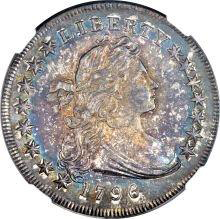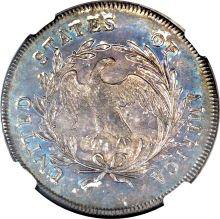 1796 $1 Small Date, Small Letters MS65 NGC. CAC. B-2, BB-63, R.4. CAC. Although the reported calendar-year deliveries of silver dollars for 1796 totaled 72,920 pieces, the Bowers-Borckardt Encyclopedia opines that most of those coins were dated 1795, and that the majority of the 1796-dated coins -- which the authors estimate at 75,000 pieces -- were struck as late as 1798.
1796 $1 Small Date, Small Letters MS65 NGC. CAC. B-2, BB-63, R.4. CAC. Although the reported calendar-year deliveries of silver dollars for 1796 totaled 72,920 pieces, the Bowers-Borckardt Encyclopedia opines that most of those coins were dated 1795, and that the majority of the 1796-dated coins -- which the authors estimate at 75,000 pieces -- were struck as late as 1798.
The silver dollars of 1796 can be categorized into three main divisions totaling six die pairings in all:
Guide Book Varieties of 1796 Silver Dollars
--1796 Small Date, Small Letters
--B-3, BB-62, R.8; B-2, BB-63, R.4; B-1, BB-66, R.4
 --1796 Small Date, Large Letters
--1796 Small Date, Large Letters
--B-4, BB-61, R.3; B-6, BB-64, R.8
--1796 Large Date, Small Letters
--B-5, BB-65, R.2 (only Large Date variety)
The present Gem B-2, BB-63 is one of the three Small Date, Small Letters varieties, a die pairing that in itself is given a rarity rating of R.4 or "very scarce," indicating a survivorship of about 118-158 pieces in all grades.
The B-1, BB-66 Small Date, Small Letters is in a similar rarity range, R.4. The third Small Date, Small Letters marriage, the B-3, BB-62, is so rare (rated R.8, "unique or nearly so") that perhaps only a small handful of pieces survive.
The B-6, BB-64 Small Date, Large Letters is in the same rarity category as the B-3, BB-62, surviving in minuscule quantities. Heritage handled the Jules Reiver Collection B-6, BB-64 certified by NCS as XF Details -- Damaged (Heritage, 1/2006), lot 23490, a coin that even then brought $27,600. At that time we published a census indicating three survivors. The John Whitney Walter ("Mr. 1796") example of the BB-63 was a Very Fine specimen (Stack's, 5/1999), lot 1249.
The B-5, BB-65 Large Date, Small Letters and the B-4, BB-61 Small Date, Large Letters are the only two die varieties of the year that might be described as "readily available," without factoring in conditional rarity.
The Present Specimen
Bowers-Borckardt Die State I. In this die state, the wreath ribbon and leaf closest to the U in UNITED on the reverse show no signs of lapping, the usually seen state. The B-2, BB-63 variety shows a small, evenly spaced wide date, with the 6 leaning markedly to the left. The flag of the 1 is small and tilts up crookedly to the left from the upright of the 1, which looks as though a small piece is removed from the top; this is probably the single most obvious identifier for this obverse, along with the leaning 6. The lowest curl touches the innermost point, only, of star 1.
This obverse was used first for the B-2, BB-63, then paired with a reverse die that failed rapidly for the B-6, BB-64, explaining the rarity of that variety.
The Small Eagle reverse die used for the B-2, BB-63 was first used for the 1795-dated B-14, BB-51, then used for several other varieties with obverses dated 1796, 1797, and 1798. The berry under the A of STATES is the quick identifier for this die.
This piece shows surfaces of marvelous beauty, deeply but engagingly toned throughout. Both sides display an inner circle of pinkish toning ceding to peripheral rings of blue. The obverse shows more of a transitional purple-colored ring between the two prevailing colors, and many of the stars, the date, and other raised devices on each side show small "shadows" of silver to one side or the other.
There are no planchet adjustment marks visible on either side, and in fact, there are few distractions of any sort, whether contact marks, luster grazes, or other impairments, to diminish what must simply be called phenomenal eye appeal. It seems almost overly picky to mention a couple of thin scrapes through Liberty's rear hair that require a loupe to see.
As often observed on this variety, the reverse strike is a tad off-center, here toward 12 o'clock, so that the dentils are longest at 6 o'clock and shortest opposite. The obverse die is a trifle better-centered but shows some of the same phenomenon, and in the same direction.
The strike through the eagle's breast is weak, more a function of the design than of this particular die pairing, and perhaps one of the reasons why the Small Eagle reverse was retired rather rapidly after a few years in favor of the Large Eagle or Heraldic Eagle reverse. The weak strike also extends downward to include the eagle's lower legs, the claws, and the clouds on which it stands.
Bowers writes in his Encyclopedia of the BB-63:
"An estimated 175 to 300 specimens exist of 1796 BB-63, another variety that is usually seen in lower grades. Above VF, acquisition becomes a challenge. Specimens are scarce if EF and very rare if AU."
It is dangerous to make too many claims concerning early dollars, as there are far fewer variety collectors than there are of, say, early large cents or half cents, and many examples of the early dollars remain unclassified as to variety, to a far-greater degree than the old coppers. Information regarding top-grade examples of each variety is also harder to come by, although the third-party grading services' populations for certified varieties -- a fairly recent phenomenon -- are of some use.
Nonetheless, when one considers the comments of Bowers above concerning this variety's conditional rarity, the very scarce rarity ranking of the BB-63 overall, and, finally, the miraculous preservation of the present Gem example, is it too much of a stretch to believe that this variety could, just possibly, be conditionally unique?
What we can say is that PCGS shows no examples of the 1796 Small Date, Small Letters -- any variety -- in Mint State, with the closest being a B-1, BB-66 in AU58. For the 1796 silver dollar, all kinds, NGC shows one each in MS60 and MS61, four in MS62, one in MS63 -- and a single coin in MS65, thereby making this incredible coin the finest-graded 1796 at that service by at least two points. And we would be more than surprised if some of those lower-graded submissions did not represent duplicates (2/13).
The early dollar specialist will recognize what an important opportunity the present coin represents, and will act accordingly.
From The William Jacob Collection
© 2013 Heritage. All rights reserved. Used with permission.